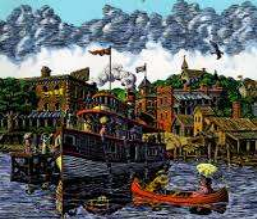Too often the places we create are placeless because they don't include our stories
- Michael Jones
 Every community and organization needs its own mythic story. The myth serves as a gateway into our deep life together. Leaders in turn shape the culture of a place through the circulation of these stories that convey their core values. Our places, in turn, become the public stage where the wisdom of these stories may be lived out.
Every community and organization needs its own mythic story. The myth serves as a gateway into our deep life together. Leaders in turn shape the culture of a place through the circulation of these stories that convey their core values. Our places, in turn, become the public stage where the wisdom of these stories may be lived out.
Most places have personal and community stories that express these values. What they don't have, however, is the larger metanarrative – a mythic larger-than-life story – that can inspire and contextualize the future they want to create for themselves. These larger 'founding' narratives are the lifeblood of any community and often serves as the most powerful building block for creating a regenerative culture for the future.
Seeing the source of our myth begins by paying attention to the extraordinary in the ordinary. We need to lift up into the imagination the mundane activities of everyday life and see within them the small miracles, the invisible vein of gold in the life of any organization or community.
For the past year we have been co-chairs of the Mariposa Roundtable 'mapping' the richness of our heritage by exploring the communities' storied connection to the mythical town of Mariposa as detailed by the much loved Canadian humorist Stephen Leacock. As the community embarks on an ambitious downtown revitalization and waterfront development plan and struggles to reinvent itself and its identity following the decline of its once thriving industrial based economy - community leaders are asking: What is the story we want to tell? That is, what is the story that speaks to our unique identity and, how can this story help us learn from our past in order to create a positive, creative and sustainable future?
In mapping the mythic story, we take up the call to be anthropologists uncovering other untold stories, forgotten artifacts, mysterious images and hidden meanings. We polish and burnish them so they may shine again and serve as the foundation of something we may become immersed in and from which everyone can learn. In viewing Mariposa as a mythic fable holding within it many elements of a wisdom story, we may ask ourselves:
- What does Mariposa mean to us now? What does it look like and how does it feel?
- What can we learn when we think about the mythic story of Mariposa that we cannot learn anywhere else? What are the key images and themes of Mariposa and what can we learn from them? How do we turn these images and themes into a storyline that will capture the imagination of visitors - or travellers and pilgrims from around the world?
- What are the key locations - culture, industries, neighbourhoods, networks, infrastructure, sacred sites that interconnect in the telling of the Mariposa story? If we were to imagine Orillia in twenty, fifty, or one hundred years, what will have changed and what will have stayed the same?
- What would the storybook of the community look like? How would our built environment, streetscapes, parks, neighbourhoods, public places and place names be different from today?
We live in a world that is increasingly interconnected and interdependent. At the same time, it is more fragmented and polarized than ever before. In this turbulence it may be our mythic stories of place that serve as the bridge from our past to our future. We may not be able to retrieve our past, but we may still be able to learn from it and what this learning may lead to a vision of a future to which we can bring our gifts and unique talents to create a place in which everyone can grow and thrive.
If you are interested in discovering the roots of your own story of place - 'Your Mariposa' we would look forward to offering the Mariposa Experience in your community. As a festival, a teaching, a conversation, as an art form 'Experiencing Mariposa' is an opportunity to discover your story of and for our time and for the future. Through the power of our stories we can bring the gift of place, community and belonging home again.
Learn more:
- Read the full article: Experiencing Mariposa
- Listen to Exploring the Soul of Place, a Tamarack webinar with Michael Jones





